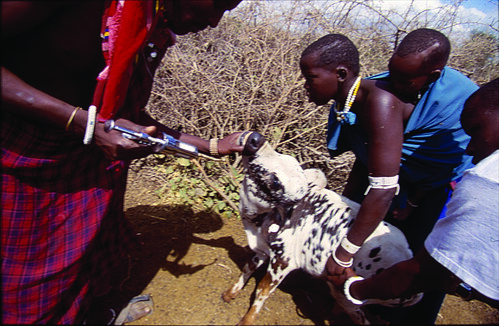 New project launched to investigate how immunity develops in cattle to fatal diseases caused by different strains of tick-borne parasites
New project launched to investigate how immunity develops in cattle to fatal diseases caused by different strains of tick-borne parasites
Tag Archives: Scotland
What did the G8 in Scotland achieve for Africa and African science?
Speaking after the conclusion of the G8 Summit at Gleneagles, the Commission for Africa spokesperson was upbeat. He said that although not all of the Commission's recommendations had been adopted, "70% is first class". Speaking after the conclusion of the G8 Summit at Gleneagles on Friday (8 July), Fola Adeola, of the Commission for Africa, was upbeat. He said that although not all of the Commission for Africa's recommendations had been adopted, "70% is first class". Nigeria's President, and Chair of the African Union, Olusegun Obasanjo was similarly upbeat and described the outcomes as a "success". The Commission for Africa had put forward powerful arguments for the critical need to build Africa’s institutes of higher education, and build science and technology (S&T) capacity through networks of centres of excellence. In March 2005 the Commission made two specific recommendations in this regard. The international community should commit in 2005 to provide: • US$500 million per annum over ten years to revitalise Africa’s institutions of higher education; and • Up to US$3 billion over 10 years to develop centres of excellence in science and technology, including African institutes of technology. (See Information Brief: Excerpts from the Commission for Africa March 2005 Report) The final communiqué from the G8 in Gleneagles contained broad statements of commitment, but few concrete details such as timelines and figures. Much of the recent focus has been on aid and debt relief for African countries – and the G8 announced a doubling of aid to Africa. According to The Economist.com (8 July), “Some poverty experts will be glad of a more measured pace of aid dispersal than previously proposed. The evidence that aid alleviates the misery of poor people in the developing world is at best mixed: dumping billions of dollars more into countries run by corrupt and/or incompetent governments may simply further entrench the dysfunctional institutions that have strangled African development for so long.” However, the increased aid deal does come with a proviso. In return, African countries have made a commitment to fight corruption and promote democracy and good governance. But what has this landmark Summit achieved for capacity building in science & technology and higher education? The G8 leaders have made a broad commitment to: “Helping develop skilled professionals for Africa's private and public sectors, through supporting networks of excellence between African's and other countries' institutions of higher education and centres of excellence in science and technology institutions.” SciDev’s editor, David Dixon is amongst those disappointed with the low profile given to S&T in the final communiqué and described it as “something of a damp squib”. He has produced a Checklist for Science in Africa, against which new proposals for S&T initiatives for Africa should be assessed. He recommends (an initial list of ten) key considerations including Think trade, not aid; and Think innovation, not science. 
